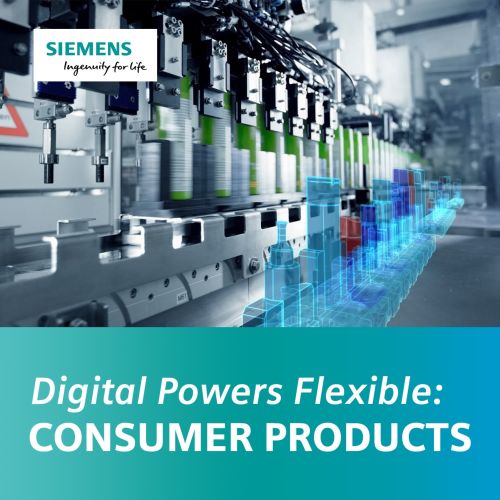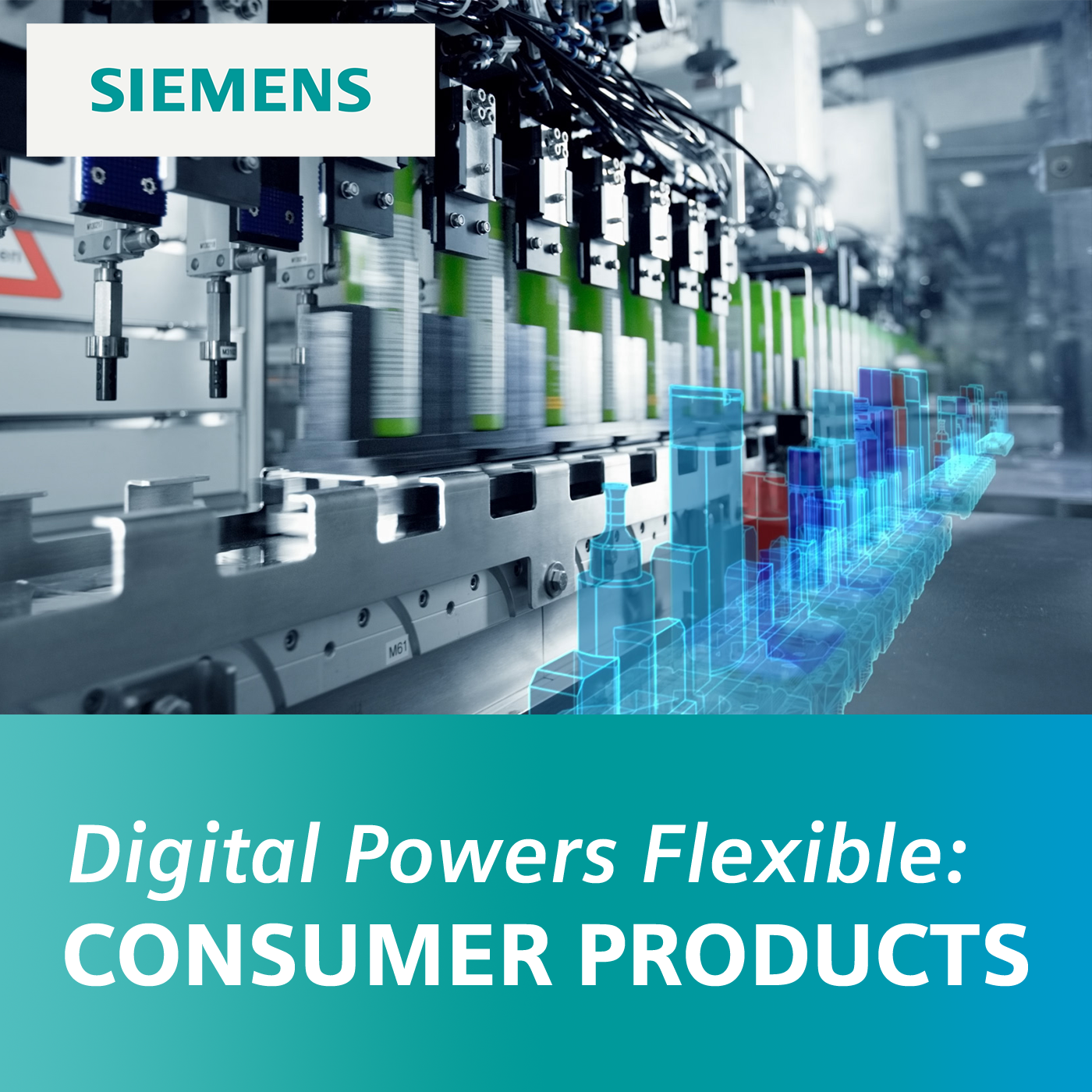Consumer Products Podcast – Enabling flexible manufacturing and supply chain resiliency (Ep. 4)

The fourth and final episode of Siemens’ Digital Powers Flexible podcast is here. To continue their conversation on how digitalization and the comprehensive twin are changing consumer products for the better, Suzanne and Alastair look at what enables flexible manufacturing and supply chain resiliency. If you missed episodes one, two or three, they are all available on the Siemens Podcast Network, as well as your favorite podcast platforms.
Summary:
How are companies today appeasing the ever-growing needs of consumers? As customers are increasingly wanting a greater depth of information before making purchasing decisions, manufacturers must find ways to increase transparency in their products and their processes. It’s no longer only about the item, but also where it came from, who made it, and how it got into your hands. Knowledge about the process, paired with the desire to customize and personalize each product, means that manufacturers need simple and flexible solutions to meet consumer needs.
In our final episode in this series, we talk about the technology which enables flexible manufacturing to exist. We’ll also discuss supply chain resiliency, something that’s particularly relevant today, where we’re seeing supply chain disruptions highlight its absolute criticality.
We’re back with Suzanne Kopcha who is responsible for industry strategy for consumer products, and Alastair Orchard, one of the first to define the company’s digital enterprise portfolio.
Some Questions I Ask:
- What happens if companies sourcing from suppliers won’t give them their data or their digital twin? (0:58)
- How can digital technology help when supply chains are disrupted? (7:17)
- How do traceability and insight help deliver the flexibility that companies need? (9:05)
- How has working in this industry changed your perception when purchasing consumer products? (14:36)
What You’ll Learn in This Episode:
- What having a “floating” factory floor in Hamburg has taught us (5:27)
- 3 ways live data can be linked to products (10:52)
- The purpose of the final digital twin, or the “bookend’ (13:56)
Connect with Suzanne Kopcha:
Connect with Alastair Orchard:
Steve Hartman: Welcome back to our fourth and final episode of Digital powers flexible, the Siemens podcast series about consumer goods. So far, we have covered the ever-changing market the consumer products industry is in, and how digitalization and a comprehensive digital twin can help this industry thrive. We also started going into three of the digital threads and how they help companies with varying portfolios stay ahead in the ultra-competitive marketplace. Today, we will see what enables flexible manufacturing as well as supply chain resiliency, which is especially relevant in these times.
Alastair, you started talking about blurring the boundaries of design and manufacturing in consumer industries, which today are often separated, through a completely integrated, seamless digital thread. But what happens if companies sourcing from suppliers won’t give them their data or their digital twin?
Alastair Orchard: We actually learned from the automotive industry. I think consumer products has something to learn from other industries because this is still a challenge for them. But it’s absolutely the right way to go. So, we will not go to tender with any machine builder that is not prepared to come back to us with a model in response to our request. That model is used to demonstrate not only do they understand our requirements, but the simulations that run against this model predict the performance of the machine. And so, we do not only choose the machine that’s the most cost-effective, but the one that predicts the best performance, the lowest energy usage, the longest mean time between failures, and of course, the one that’s most compatible with the rest of our manufacturing workflow. We then choose one of these companies who have to provide us with a definitive final digital twin three months before the machine arrives. We then, go through what’s called a virtual commissioning phase – so, we commissioned that machine in production. That is, we hook it up to the other machines, we link it into our reporting systems, we run logistics optimization, we train operators on the operation of that machine, we train our maintenance staff on that machine before the machine arrives. And then, when the machine physically arrives, 40 minutes after it comes in the door, it’s already hooked up and completely operational and the typical time is three to six months. So, if you go to a typical consumer products company, maybe they’ll wait 15 to 18 months for a machine to arrive. That’s the first time they’ll have seen that in any shape or form and it’ll take three to six months for them to hook that up, build it into a line and get that line fully operational. We did it in 40 minutes.
Suzanne Kopcha: Most of my customers are asking for an instantaneous startup when they finally get receipt of the machine, which has never been possible before. With virtual commissioning, can all that work be done really ahead of time and have an instantaneous startup? Or in 40 minutes?
Alastair Orchard: Yeah, exactly. Instantaneous is pushing it. Yeah, we’re down to 40 minutes, which isn’t bad.
Suzanne Kopcha: Yeah, it’s pretty instant as compared to months. One of the things that struck me when you were talking is designing and optimizing the production environment when you first get it and set it up. There’s massive benefits to all of this digital technology. But, what about maintenance and servicing of the equipment and keeping that digital twin alive through the life of the equipment? Can that be done as well?
Alastair Orchard: Yeah, this is absolutely not a one-way process. The arrow of time doesn’t simply go from design through to production – real product – and then we start again. It’s iterative. You mentioned the collaboration platform at the beginning of the podcast, and this really comes into play in answering this question. One of the main jobs of that platform is to provide access to the entire organization to see both the digital twin of an asset and the real asset itself and to allow them to compare predictive performance to actual performance. And we do that for products – so, how do we expect the product to perform? Let’s monitor how it actually performs in the real world and let’s use any deviations there to maybe tweak the firmware, push out new adjustments to the product while it’s being used by our customer, let’s use big data to collect the results of thousands of monitored products and modify the design of the next generation of product. We also use it in our factories. So, we talked a lot about using simulation to create foresight. We use the data that we collect continuously from the real factory to deliver insights back into machine design, into manufacturing planning into operations, in order to keep machines working optimally. And it’s not just the question of predicting and optimizing maintenance, it’s actually modifying and optimizing continuously the way the factory works. In Amberg , again – I talk a lot about this factory, but it’s where we kind of cut our teeth on these things, so it’s a good place to talk about – all the machines sit on a kind of floating floor, floating as in raised. It’s raised for a couple of reasons. The first is that underneath the floor is where the warehouse is, and this allows us to deliver products to any place in the factory, flexibly. The second reason is that we need to move those machines around continuously. So, every Sunday, we take a look at the predicted mix of products that we’re going to make in the upcoming week. We then run plant simulations. There’s a genetic engine in there in order to optimize the layout of the factory in order to minimize the length of those journeys that I was talking about previously, on average, over the week; we’ll then stop the factory briefly, unplug all the machines and move them around. Every month we move 40% of the machines within the factory in order to optimize layout. So we’re continuously optimizing a machine, tweaking it, keeping it running, keeping it optimized, using IoT and analytics. We’re continuously looking at the macro layout of the factory and optimizing that. And this continuous monitoring, continuous feedback, and then using simulation to continuously predict how best to operate is really a mantra which is at the heart of the entire digital enterprise.
Steve Hartman: You’ve talked a lot about the need for flexible manufacturing, but what we’re seeing in the media is things around the supply chain disruptions and the need for supply chain resiliency. Can digital technology help with that?
Suzanne Kopcha: You are absolutely right! One of the things that we’re seeing enormous amounts of conversation amongst customers in the media is around the disruptions that are happening in the supply chain and the absolute criticality of supply chain resiliency. And we need that. We absolutely need that for the manufacturing resiliency that we need and the flexibility that we need in manufacturing to be responsive to the demands in the marketplace. So, there’s lots of technologies that people are looking at. The other heart of this that’s become really interesting is, if we go back to the question – or the context that you had provided before – around the razor and the foam in that pack of product that you wanted, many, many companies are seeing a significant shift to these customized or configured packs of what used to be considered individual finished products that would have been sold or may also be sold to consumers individually. So, to be able to put those packs together, a whole new part of the supply chain is being developed. Some people do that in their distribution center, some people are creating customization centers that today, we find are very manual. But the ability to have the flexibility that they need in pulling all of these customer-configured packs together will require automation for them to be able to deliver to the consumer with the speed and agility that they need.
Steve Hartman: The fifth digital thread is around traceability and insights. We talked previously about the need consumers have for proof and the role that lifecycle intelligence plays in creating the flexibility companies need. How does this thread help deliver that?
Alastair Orchard: Maybe I tell you one of my little stories again. I was in a very interesting meeting with one of the world’s largest consumer products companies quite recently and they were explaining to me that their entire business model was predicated on the idea that consumers bought based on brand recognition and trust in the brand, and so, all their focus apart from making great products was on ensuring that consumers recognized their logo, recognized their brand name, associated that with quality, and then, when a consumer walked into a supermarket or a store, they instantly saw and recognized products from that brand.
Steve Hartman: The arrival of millennials a couple of years ago changed everything: This new generation of consumers no longer cares so much about the brand. They’re not brand loyal. They’re data loyal. So, they care about the characteristics of the product.
Alastair Orchard: We’ve talked about some of those characteristics before. A product has to support their lifestyle – it has to be vegan or local or rainforest friendly or palm oil-free – and so, companies began certifying their products and sticking logos all over them – rainforest friendly logos, or whatever, organic logos – and the millennials really didn’t care. It didn’t resonate with them. They saw these labels printed on every single packet from every single company, and no one stood out from the crowd. And so, what they realized was, in order to prove to the consumer that these claims are true, they would have to link live data to the product. And this is really achieved with a combination of three technologies.
The first one are the mobile technologies, which we all hold in our hands – the cell phone – the second one is blockchain and the third is IoT. And so, our traceability and insights, digital thread actually collects proof points using IoT – that’s the Internet of Things technologies – from the entire value chain, from farmers growing crops in the field through the logistics companies that move those products into pre-processing networks of pre-processing factories. So, if we’re making a chocolate bar, then that chocolate will have come from maybe South America, it will travel across the world; so will the milk – the milk will come from local organic farms – the biscuit inside will be made of flour coming from North America, and all these products have to be traced, their origins understood and certified, the sustainability of their journey into manufacturing, the combination of these raw materials in manufacturing have to be completely transparent, and the journey of these certified transparent products have to be made available in a trustworthy application directly on the consumer’s cell phone.
This allows brands to prove to the customers that their claims are true, it allows them to differentiate from all those stickers and badges on regular packets, it allows us to build a new kind of relationship with customers. Our manufacturers are using this to tell stories about the product. The transparency goes all the way back to the farmer in the field. They’ll name the farmer, they’ll explain when the products were harvested, what the weather was like, they’ll describe the maturation process of the whiskey that’s being drunk, the name of the Cooper who made the barrel – so, it’s a way of getting closer to the consumer, personalizing their experience, gaining feedback about that product, and doing it in a way which helps drive better and better products. So, this is the backbone of traceability and insights – insights, really, coming from that feedback process, but coming also from the application of machine learning and artificial intelligence to the massive data that we’re collecting, looking for opportunities in the supply chain for additional profits, looking for opportunities to reduce waste and make products more sustainable, opportunities to identify new markets and satisfy customers – and that’s really the basis of this final digital twin which I remember, Suzanne, you called it ‘bookend’, right?
Suzanne Kopcha: Yeah. I just think that the beginning of Integrated Program Lifecycle Management is all about innovation and the innovation portfolio broader than any one product that we’re designing and manufacturing and the new relationship with the consumer around traceability and the insights that we can get across the value chain is the other end of that bookend. They’re both pervasive, and not about any one product’s designer or manufacturer, but collectively about the system – almost the systems of systems, within all of these companies, and how to optimize that whole digital enterprise.
Steve Hartman: How has working in this industry changed your perception when purchasing consumer products?
Suzanne Kopcha: I’ve been in this industry for 30 years. I’ve been in the industry almost as long as I’ve been buying products. At the beginning, it was really about extreme loyalty. It was kind of funny when I was listening to Alastair’s story because that was me. I think part of it was I worked for one of the largest consumer products companies, so I was very loyal to its products. But now, at a different time and in a different position, when I go buy products, I try as many different things as I can. One, because I want to support our customers and I want to know their products. But two, just a different life stage – I’m now very inquisitive about all the different kinds of products in the industry and the different promises that people make. But I also look at the quality of products, and I have a much better appreciation of the complexity that it takes to make them. I often actually wonder how people make money because of the complexity they deal with and the relative really small price points that we have in most of the industry. Of course, when we get into very high-end apparel or accessories – that $4,000 Louis Vuitton purse or appliances for our homes – those are much bigger price points, but a lot of the industry is very small price points. So now, I’m much more discerning and much more appreciative and I often look for value and if a company delivers value, then I’m willing to pay for it. So very different now that I know a lot more about the industry than when I started. But I think it’s also a bit of how I’m not a millennial, but you know how Alastair talked about millennials really spending their dollars where data and value are delivered.
Alastair Orchard: Well, I agree with Suzanne. I like to brew beer at home, I like to bake bread at home, I like to use my hands in order to make things, and I am continuously amazed how long it takes me. It’s satisfying. But I can go out and acquire artisanal products that have been manufactured at scale, and I’m one of 9 billion people on the planet. So, really, being involved in this industry, I agree with Suzanne, it’s like a miracle. And the more you peel back the onion, the more you know about what goes on, the more amazing it is and I’m just happy to be a part of it. Every year that goes by, as more and more companies adopt our technology, we see that the industry can deliver safer products more effectively, and it’s extremely satisfying.
Steve Hartman: And with this, we are ending our podcast series about consumer goods. It was my great pleasure to host this series – Suzanne, Alastair, you’ve been great guests! To our listeners: You can find all these episodes on your favorite podcast platforms or on our blogs.sw.siemens.com under podcasts.
Thank you.
For the consumer products industry, there are three processes enabled by the digital twin that are critical for the future of the industry – virtual commissioning, maintenance & servicing, and traceability.
Virtual Commissioning
This process for consumer products took many cues from the automotive industry, and there is still much to learn, but, any partnered machine builder must submit a model of the requested machine. That model is used to demonstrate not only do they understand our requirements, but the simulations that run against this model predict the performance of the machine. Machine selection should no longer be based solely on what is the most cost-effective, but one with the best predicted performance, the one with the lowest energy usage, the longest mean time between failures, and most importantly the one that is most compatible with the rest of the manufacturing workflow.
Virtual commissioning should then begin three months before the final machine arrives on-site, to be run off of a highly detailed digital twin of the machine from the manufacturer. we hook it up to the other machines, we link it into our reporting systems, we run logistics optimization, we train operators on the operation of that machine, we train our maintenance staff on that machine before the machine arrives. And then, when the machine physically arrives, 40 minutes after it comes in the door, it’s already hooked up and completely operational and the typical time is three to six months.
Maintenance and servicing (Supply chain resiliency)
A fully operational machine is not the end of the digitalization journey either, one of the main jobs of a collaborative platform is to provide access to the entire organization to see both the digital twin of an asset and the real asset itself and to allow them to compare predictive performance to actual performance. It can monitor actual performance in the real world and use any deviations there to tweak the firmware, push out new adjustments to the product while it’s being used by our customer. Using big data to collect the results of thousands of monitored products and modify the design of the next generation of product. That continuously collected data from the real factory can be used to deliver insights back into machine design, into manufacturing planning into operations, in order to keep machines working optimally.
And it’s not just a question of predicting and optimizing maintenance, it’s modifying and optimizing continuously the way the factory works. This was especially important in Siemens’ Amberg facility, where 40 percent of the machines in the factory were moved every month to optimize the factory layout. We’re continuously optimizing a machine, tweaking it, keeping it running, keeping it optimized, using IoT and analytics. We’re continuously looking at the macro layout of the factory and optimizing that to best produce for market demand.
Traceability
For many other industries, the use of traceability is based on safety standards and finding errors in production, and while this is applicable for consumer products it is not the entire value. Many consumer have lost brand loyalty and but products based on how they are manufactured. Is it vegan, locally produced, rainforest friendly or palm-oil free? The certifications many brands started getting for these questions did not resonate with these new consumers, they still did not trust these claims because every brand was making them. To prove these claims, we thought to link live production data to the products themselves by combining three technologies – mobile computing with cell phones, blockchain and IoT.
IoT, throughout production, collects proof point for how the product is being made, how the logistics companies are delivering the product and even the name of the farmer picking the raw materials from the field. This information is added the end-product’s signature with blockchain. That can then be examined by scanning a label with a smart phone. It is a new and transparent way to communicate with the customer and build a relationship based on trust.

Suzanne Kopcha – Speaker
Suzanne has been a part of Siemens for over five years and is responsible for industry strategy for consumer products; before joining Siemens, she spent 25 years at Procter & Gamble.

Alastair Orchard – Speaker
Alastair runs the Digital Enterprise Thought Leadership team for Siemens Digital Industries, working with multinationals to become more flexible, cost effective, transparent, collaborative organizations, and to bring their world-class products to market faster than their competitors.

Steve Hartman – Host
Steve has been at Siemens for over two years and is responsible for writing various content as well as producing videos and podcasts.

Digital Powers Flexible
Digital Powers Flexible: Consumer Products is a podcast brought to you by Siemens Digital Industry Software.
